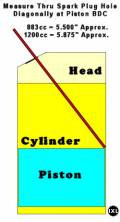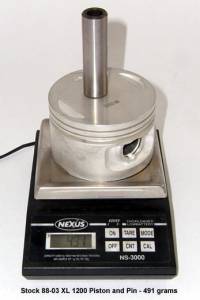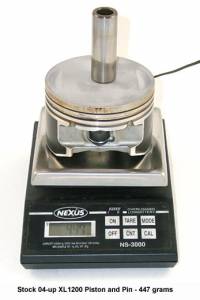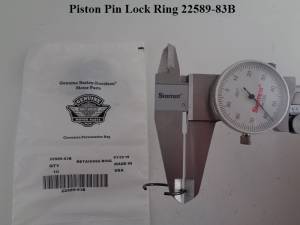Table of Contents
This is an old revision of the document!
EVO: Engine Mechanicals
Cylinders, Heads, Pistons & Rods
Sub Documents
Cylinder Pressure - Compression
Cylinder Pressure Test
It is important to make a check of your cylinder pressure (aka engine compression) as soon as you obtain your bike and, at least, on an annual basis thereafter. This is a great reference value to determine if the pistons, rings, cams, lifters, pushrods and valves are all functioning correctly together. Over time, these parts wear and your cylinder compression will reflect when these items should be checked, adjusted or replaced.
New compression readings should be taken whenever any type of headwork, valve reseating, new head gaskets, etc., is performed in order to evaluate the operational functioning and to have a new reference point for the future.
To check your cylinder pressure, you need a compression tester/gauge. For less than $25, you can buy (online) a tester with a gauge, hose and adapters (slightly more at your local auto supply or department store).
Using The Compression Tester1)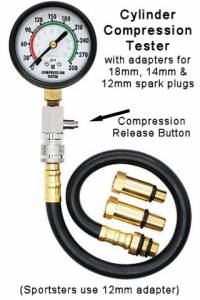
- Run the engine to get it up to operating temperature (maybe a 10-15 minute ride)
- Let the engine cool down just enough so you can work with it
- Disconnect and remove both spark plugs
- Screw the compression tester into the spark plug hole for the front cylinder
- Lock the throttle open
- Critical - Remove the air cleaner & hold the CV Carb slide up (other carbs, make the choke fully open)
- Crank the engine for several rotations until maximum pressure on gauge
- Record the final reading
- Repeat this procedure for the rear cylinder
Results The difference between the two readings should not be more than 10%. A low reading on either cylinder indicates a possible valve or piston ring issue. To determine which, pour about 1/2 teaspoon of oil into that cylinder through the spark plug hole. Then repeat the compression test. If the reading returns to normal the rings may be defective. If the compression does not increase to within 10% then the valves of that cylinder may require service.
Compression test results vary on stock models but, typical rule-of-thumb is a minimum of 120PSI for 883 engines & 150PSI for 1200 engines.
Cylinder Leakdown Test
If you find you have low compression in a cylinder, you will want to do a Leakdown Test. This test will help determine the location of the leaking air, such as worn exhaust valves, worn intake valves, leaky head gaskets, or worn rings.
The test should be donw when the engine is at or close to normal operating temperature, such as right after doing the compression test.
To perform the test, you will need an air compressor, a Leakdown Tester (around $50 online) and something to listen for air leaks, like a mechanics stethoscope (with the probe removed) or a length of oil line hose. (A small air compressor can be had for under $100, but if you purchase one that can produce 5cfm or more at 90psi, you can use it for some air tools as well.)
Using The Leakdown Tester2)
- Run the engine to get it up to operating temperature (maybe a 10-15 minute ride)
- Let the engine cool down just enough so you can work with it
- Disconnect and remove both spark plugs
The Piston must be at TDC on the compression stroke so that both intake and exhaust valves are fully closed. You can do this (a helper is useful here) by turning the rear wheel to move the piston:
- Lift the bike or block the rear wheel off the ground
- Put the transmission in 4th gear
- Place your thumb over the spark plug hole of the cylinder you intend to test
- Have a helper rotate the rear wheel as you feel for pressure on your thumb
- When you feel it, place a strat or other long stick into the cylinder and continue to rotate the wheel until the straw stops rising
- This is TDC and both intake and exhaust valves should be closed
Now you are ready to use the tester: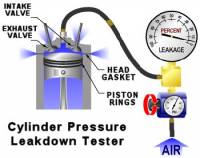
- Turn on the compressor, connect the gauge to the air pressure, and adjust the gauge
- Thread the adapter into the spark plug hole and into the guage
- The gauge will now show the amount of leakage
There will always be some leakage, especially past the rings, but:
- Listen at the exhaust pipe. Excessive hissing here indicates the exhaust valve is not sealing
- Listen at the Air Cleaner intake. Excessive hissing here indicates intake valve[s] not sealing
- Listen at the timing plug hole. Excessive hissing here indicates the rings are not sealing
- Listen around the cylinder/head gasket. Excessive hissing here indicates the gasket is not sealing
- Greater leakage of air results in the sound being of a lower pitch.
There are many variables here [engine temperature, precise piston position, whatever]. The test results will not be consistent from one test to the next, so multiple tries should be recorded and a consensus value established.
Cylinders
1986-2003 EVO Cylinders
Boring Cylinders
Final cylinder bore sizes after honing. 3)
| Bore Sizes | 883cc | 1100cc | 1200cc |
|---|---|---|---|
| Standard Bore* | 3.0005 in | 3.3505 in | 3.4978 in |
| 0.005 OS Bore | 3.0048 in | 3.3548 in | 3.502 in |
| 0.010 OS Bore | 3.0098 in | 3.3598 in | 3.507 in |
| 0.020 OS Bore | 3.0198 in | 3.3698 in | 3.517 in |
| 0.030 OS Bore | 3.0298 in | 3.3798 in | 3.527 in |
| 0.040 OS Bore | 3.0398 in | 3.3898 in | —- |
* All bore sizes +0.0002 in
- When cylinder requires boring beyond 0.040 in 883cc or 1100cc or beyond 0.30 in 1200 cylinders, the oversize limit has been exceeded and the cylinder must be replaced.
- Boring and honing must be done with gaskets and torque plate in place. Bore the cylinder to 0.003 in under the desired finished size. Hone the cylinder to match the piston clearance using a 280 grit rigid hone followed by a 240 grit ball hone. Hone from the bottom end (crankcase side) of cylinders working for 60 degree cross hatch pattern.
Cylinder Bore Service Limits
| Bore Sizes | 883cc | 1100CC | 1200CC |
|---|---|---|---|
| Standard Bore | 3.0035 in | 3.3535 in | 3.5008 in |
| 0.005 OS Bore | 3.0078 in | 3.3578 in | 3.505 in |
| 0.010 OS Bore | 3.0128 in | 3.3628 in | 3.510 in |
| 0.020 OS Bore | 3.0228 in | 3.3728 in | 3.520 in |
| 0.030 OS Bore | 3.0328 in | 3.3828 in | 3.530 in |
| 0.040 OS Bore | 3.0428 in | 3.3928 in | —- |
Take note:
Since the 2009 model year, the 883 cylinder construction changed dramatically and you can no longer bore them to 1200 at all.4)
Check Your Cylinder Size With a Straw
883 or 1200? - Check like this: 5)
- Put in 5th gear
- Lift rear wheel
- Remove spark plugs
- Place a long plastic straw, chopstick, etc. in the spark plug hole
- Rotate tire to move cylinder to bottom dead center - lowest straw position
- Check cylinder diagonal dimension from far bottom of cylinder to top lip of spark plug hole
- 883 bore = 5.5“ Diagonally —- (Actual Bore Dia. is 3.000)
- 1200 bore = 5.875” Diagonally - (Actual Bore Dia. is 3.498)
The plastic straw is unable to damage the cylinder and unlikely to fall into the cavity…
Heads
Torque Sequence:
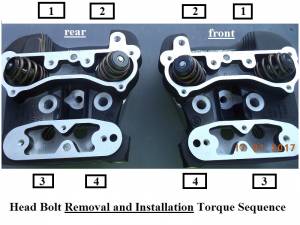 6)
6)
If you put an 88-03 style piston into an 04+ bike, the skirt on the side will smack into the oil squirter and break it off.
It's a full tear down to fix. 7)
Pistons & Rods
Rocker Arms
Pushrods
Gaskets
Gasket thicknesses are especially useful when setting squish clearance. 10)
The squish band is the quench area. 11)
The idea is to create turbulence in the chamber which helps the fuel air mix blend and distribute in the chamber.
So the squish is determined by the length of the barrels and the gaskets PLUS the deck height of the cases from crankshaft centerline.
(assuming the rods and pistons are correct) to the cylinder base)
You can buy several different brands / thickness i.e., (.010“ and .020” base gaskets) and (.030“ and .040”) etc. head gaskets to get the desired numbers.
See more on the squish band here in the REF section of the Sportsterpedia.
Base Gasket
04-up:
Harley base gasket (HD 16789-04) measures .014“ in thickness and comes in the top end kit (HD 17049-08).
Cometic has .010” and .020“ thick base gaskets.

